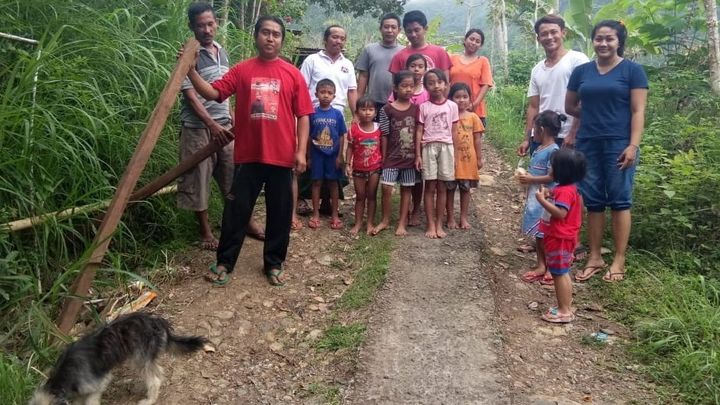
Build Infrastructure, Fight Poverty
Donation protected
Please Help Repay an Act of Altruistic Kindness. Build infrastructure and reduce poverty in an Indonesian village
Quick Summary: The people in an impoverished village in Indonesia risked their own safety and kindly provided aid to a foreigner after a car crash. I believe small acts of kindness like this should be recognized and paid forward, so they may lead to future acts of kindness and generosity. I'm sure you've donated to huge NGOs, particularly during emergencies. They do good work, but I have no idea where my donation goes - hopefully not to their CEOs. This Seraya Village project is small, but can make a big difference for this village. And you will know exactly how your donation is used.
Outline:
I. The Story
II. The Backstory
III. Life and Roads in Seraya Village
IV. The Project Plan
1) Results of Needs Assessment
2) Impact of Road Building Project (in the peoples' own words)
3) Project Scope
4) Project Cost Estimates
5) Maximum Transparency and Real-Time Updates
6) The ASKs
7) Acknowledgements and Thanks
I.
Recently, the people from a poor rural village in Seraya, Bali, Indonesia, showed great kindness after observing my car sliding down the mountain backwards, over large rocks, and into a waste drainage ditch along the side of their unpaved, one-lane road. About 20 men, women and children came out to help at night in the pouring rain. The road is clearly rough and unpaved, but it's hard to appreciate how a car would slide backwards and get stuck here (see PICTURE 1 below - taken weeks after accident, courtesy of Gede, from Tulamben). I've included a picture of what these roads look like after a heavy rain (PICTURE 2, courtesy of Deni, from Seraya).
First we tried to push the Toyota Avanza out of the ditch without success; the rear was solidly fixed on rocks. There was not a single shovel in this entire village, so we began digging the rocks out by hand. About 15 minutes later a man arrived with a 3 ft long metal bar (a piece of construction rebar) - a more effective tool than our fingers. We dug out several 1-2 ft diameter rocks and then attempted to push the car out again, but half of it was trapped in the ditch, and the other two tires spun on the muddy, unpaved road surface. It didn't help that there wasn't much tread left on the rental car tires. Unfortunately, while we were digging out the front left tire, we struck a buried portion of the main water line for the entire village (PICTURE 3).
A young man named Koming, who would become the first contact in the village, suggested it was time to call the rental car company for help. But Koming looked at my dead cell phone, and I looked at his well-charged cell phone without a single bar of cell service, and we both shrugged. Should I just sleep in the car and walk down the mountain in the morning to then ask for help? This kind group of people wouldn't give up. I think we got about 6-8 men and women around the front of the car and attempted several times to lift the front end out of the ditch, but this effort was futile; the engine end of the car wasn't liftable.
Since I had grown up in the northeast U.S., I had experience with freeing a car when it was stuck in snow - shouldn't this same principal work with mud? After pointing to several trees and making an axe-swinging motion, a few children were dispatched, and within 15-20 minutes had arrived with several pieces of wood (PICTURE 4). Simultaneously, a few lifted the car at each wheel and another dug under the tire with the metal bar, while I spiked a long piece of wood under each tire. What seemed like an entire village of people positioned themselves behind the car, they pushed while I slowly depressed the gas pedal, and finally, after hours of work, in the dark, in the rain, in the jungle, my car was freed!
But... I was still lost in the jungle, at night, in the rain, with a terrible map and a dead cell phone. Once freed, a man hopped inside my car and guided me to an area where I could turn around and head back down the mountain. We then drove down to the crash site and stopped. I was amazed to receive an escort of scooters that for 30 min guided me back down the mountain to the main road - at night, through the mud, in the rain (PICTURE 5). After hours, by 10 PM, I was again on the road to Amed.
PICTURE 1: Some of the kind people who helped a stranger free his car from the mud, rocks and a ditch in their village. The left side of the picture is the site of the accident.
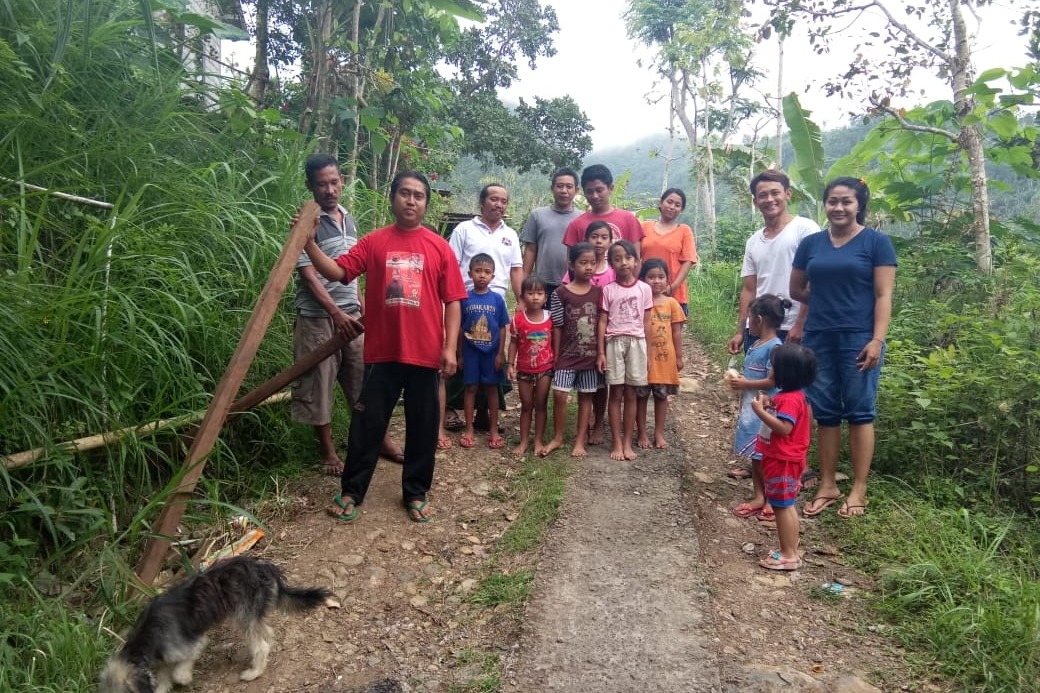 Adults, from left to right: Made Sulendra, Wayan Pater, Made Mangku, Ketut Wirti, Kadek Ami and Putu Nova; Children: Luh Juni (10), Kadek Dwi (7), Kadek Dodik (5), Ketut Purnami (10), Ketut Sri (10), Wayan Febri (9) and Kadek Ari (5). The guy in the white T-shirt on the right side is Gede, a SCUBA dive master and friend from Tulamben. He visited this village to meet with elders/leaders and do a needs assessment.
Adults, from left to right: Made Sulendra, Wayan Pater, Made Mangku, Ketut Wirti, Kadek Ami and Putu Nova; Children: Luh Juni (10), Kadek Dwi (7), Kadek Dodik (5), Ketut Purnami (10), Ketut Sri (10), Wayan Febri (9) and Kadek Ari (5). The guy in the white T-shirt on the right side is Gede, a SCUBA dive master and friend from Tulamben. He visited this village to meet with elders/leaders and do a needs assessment.
PICTURE 2: The roads in Seraya Village after a heavy rain. Not the exact same spot where the crash occurred, but it looks pretty similar to the stretch of road on the night of the accident. If you lived in this village and there was an emergency, how would you get your family to the hospital through this?!
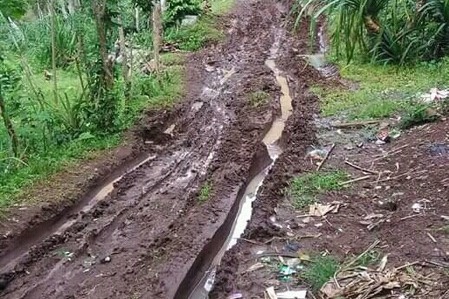
PICTURE 3: Note the white PVC pipe. While digging out the front left wheel, we accidentally broke this tube - the main line providing water to the entire village that flows from a collection pool atop the mountain.
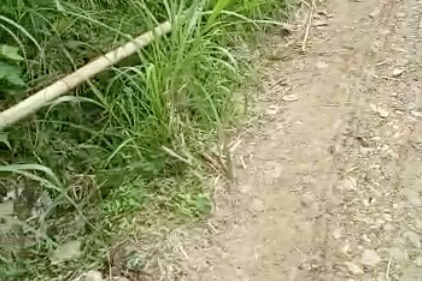
PICTURE 4: Wooden poles we fixed under each tire to free the car from the ditch and mud.
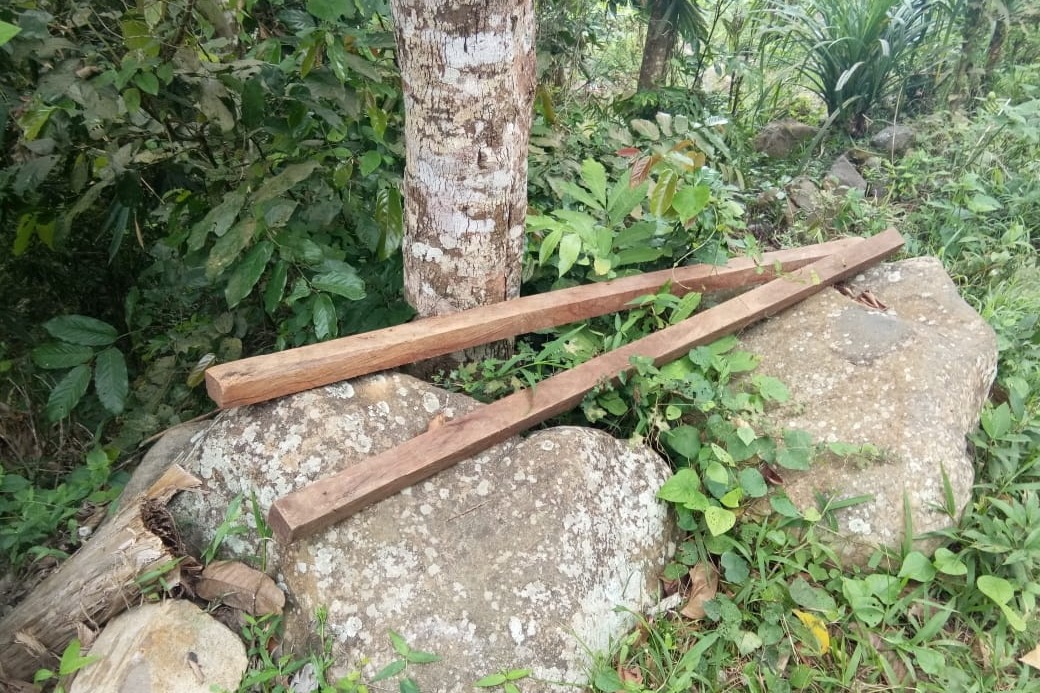
PICTURE 5: Scooter escort back to the main road to Amed.
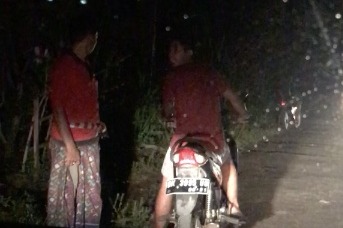
II.
The backstory: How did I get into this situation? When I picked up my rental car at 2 PM at Ngurah Rai International Airport, I was told it would take about 2.5 hours to arrive in Amed, a well-known SCUBA diving destination to the northeast of Mt. Agung volcano. I was handed a map from the rental car representative; one of those poorly-detailed red and white maps that looked like it was from the 70s or 80s. There appeared to be two ways to get to Amed: over the mountain or along the coast. The coastal route looked shorter, but the squiggly white lines appeared ominous. I pointed at the map and asked, "which way?" He pointed at the squiggly white lines along the coast, "good road." Just in case, I had a few backup systems in place: I purchased a local sim card and data plan for use with my unlocked iPhone, and I had a backup battery. The man told me, "if you get lost, no problem, ask for directions. People are nice."
I was well on my way to Amed by 2:30 PM and anticipated that I'd arrive by 5 PM, with one and a half hours to spare before sunset. By 7 PM, it was dark, there had been a steady downpour of rain for over two hours, and I was only halfway to Amed. My iPhone battery had died because that's what 3-4 year-old iPhone's do when you accept the Apple updates. The attempt to charge my dying iPhone with my Mfi-certified power cord failed: "This accessory may not be supported." (I attempted all the tricks without success).
So sometimes many unlucky factors come together and you get lost in the jungle, stuck in a ditch, at night, in the rain, and it takes you nearly 10 hours to make a 2.5 hour journey. Or, fate brings you into the lives of these kind people.
III.
Life and Roads in Seraya Village
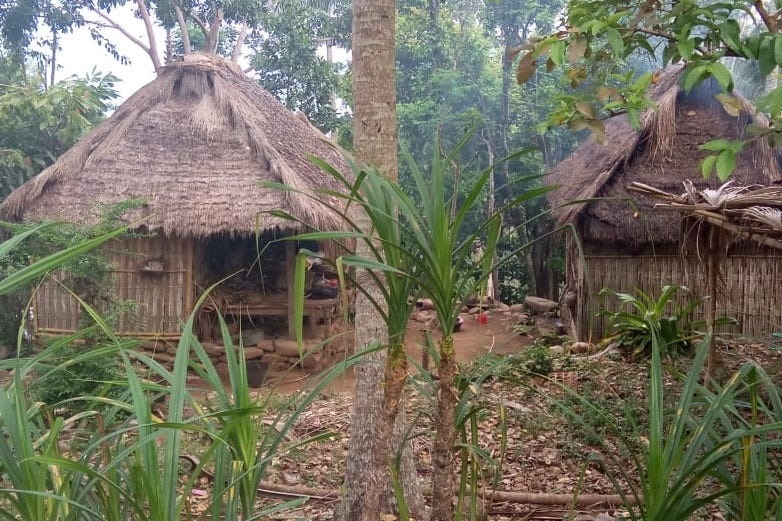


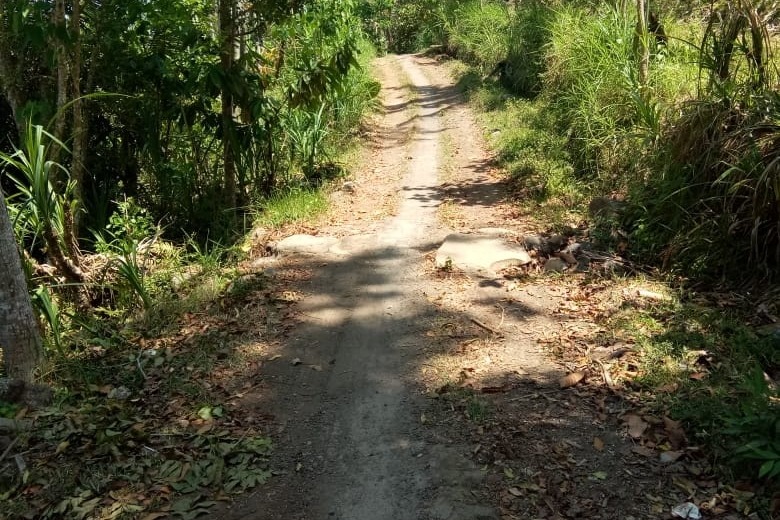

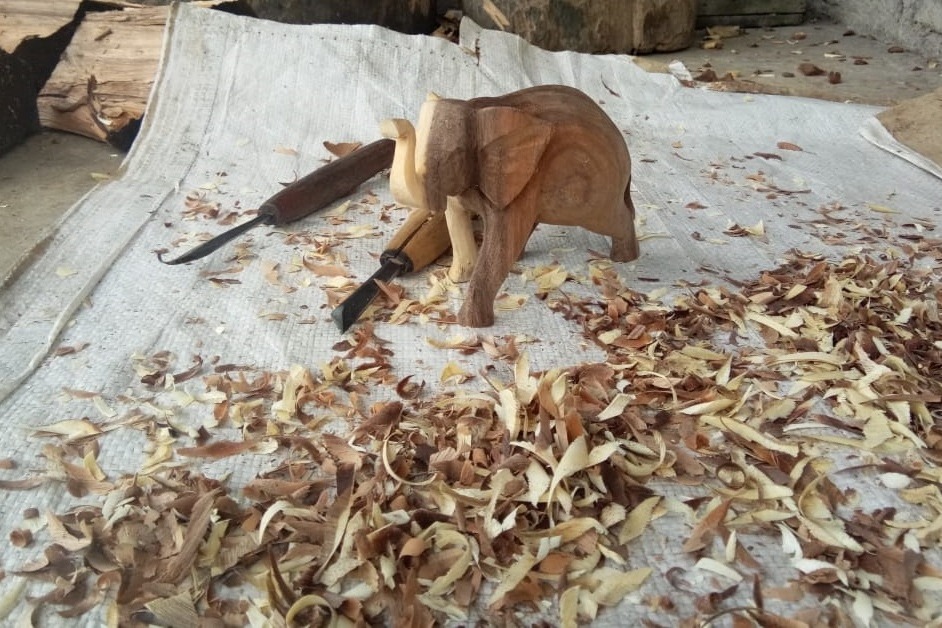
IV.
***PROJECT PLAN***
1. Needs Assessment. Village elders were asked what are the greatest needs of Seraya Village. Schools are well-supported by the government, but infrastructure is not. Village elders requested a road building project (thanks, Gede)
2. Impact of road building project, Village feedback (thanks, Deni):
a) Safety:
"Currently road can barely be accessed by a car, in case something emergency happens in my village so we will be easily handle by a car or a big vehicle"
"All villagers will feel safe when they're driving, as we know sometimes there are two or more drivers come from opposite side, and one of need to stay outside to give a way
b) Access:
"As in my village, the villagers are more Hinduism, so the main thing is to make an easy way/access to reach the temple."
"All villagers will be more easily to go everywhere with in a big size of road as they don't need to follow just one line of road."
c) Economic Development:
"For economic and tourism purposes also will be better with a paved road, as we know there are so many beautiful spots."
"And for the village development also will be very good, as if there's a big paved road, we will be easily to distribute all needed or materials for the development."
***Additionally, the unemployment rate in Seraya Village is > 50%. This project will provide months of employment with a fair wage for nearly half of the village inhabitants.
3. Project Scope.
If we fund construction of 1.6 Km of paved road, it will connect Seraya Village to paved roads on either side; one from the south side of the village (connection to resources and materials), and one to the northwest side (connection to the Hindu Temples and access for tourism). We've priced materials and labor for 0.5 Km, 1.0 Km and 1.6 Km. The length of road we can build depends on funds raised. Building the full 1.6 Km is the ideal, but per the Village elders, any length will have a significant impact on a, b and c, above. (see MAPS 1 and 2 below)
MAP 1: 1.0 KM

MAP 2: 1.6 Km
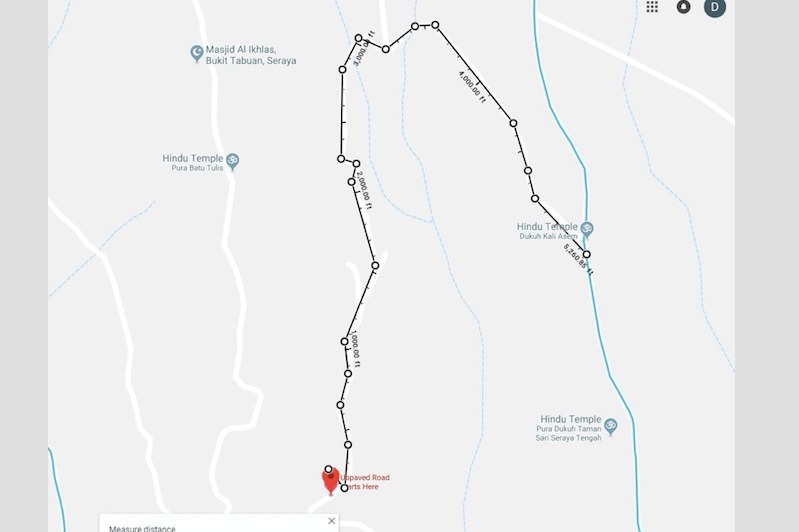
4. Project Cost Estimates
Link to Project Cost Estimates and Rupiah to US Dollar Conversions - Original and Translated
5. Maximum Transparency and Real-Time Updates
-All progress updates will be posted to this website in real time.
-The project account in Indonesia and the balance will be clearly posted on this site.
-When we reach the 0.5 Km funding goal, we will begin the project, including purchase of road building materials. All receipts, originals and translated versions, will be posted to this website. When materials are delivered to Seraya Village, pictures of delivered materials will be posted to this site.
-Regular road building progress reports with pictures will be posted to this site.
-Pictures of the final product will be posted to this site.
AND
-Descriptions and pictures of the IMPACT on Seraya Village will be posted to this site.
-Nearly all donors will be family, friends and friends of friends. You know where to find me, and you will hold me to these promises!
6. The ASKs:
1) PLEASE DONATE $10. Let's RECOGNIZE and REWARD altruistic acts of generosity in this world. I'd say 'simple acts,' but helping a stranger dig his car out with your hands for greater than two hours in the rain seems more than simple.
2) PLEASE SHARE with your Networks: Facebook, Twitter, LinkedIn, etc. etc.
3) PLEASE TELL THIS SIMPLE STORY. It could have happened to you, your family or your friend. Among so much negative news, this is a simple story of kindness, and the potential to make a huge difference, with a small investment.
7. Acknowledgments and Thanks.
-The kind people of Seraya Village
-Gede (and his wife and cousin) from Tulamben
-Deni and Koming (and his Uncle) from Seraya Village
-Awan from Ubud (and Goya for employing him)
-All the Donors who will make this project a reality
Quick Summary: The people in an impoverished village in Indonesia risked their own safety and kindly provided aid to a foreigner after a car crash. I believe small acts of kindness like this should be recognized and paid forward, so they may lead to future acts of kindness and generosity. I'm sure you've donated to huge NGOs, particularly during emergencies. They do good work, but I have no idea where my donation goes - hopefully not to their CEOs. This Seraya Village project is small, but can make a big difference for this village. And you will know exactly how your donation is used.
Outline:
I. The Story
II. The Backstory
III. Life and Roads in Seraya Village
IV. The Project Plan
1) Results of Needs Assessment
2) Impact of Road Building Project (in the peoples' own words)
3) Project Scope
4) Project Cost Estimates
5) Maximum Transparency and Real-Time Updates
6) The ASKs
7) Acknowledgements and Thanks
I.
Recently, the people from a poor rural village in Seraya, Bali, Indonesia, showed great kindness after observing my car sliding down the mountain backwards, over large rocks, and into a waste drainage ditch along the side of their unpaved, one-lane road. About 20 men, women and children came out to help at night in the pouring rain. The road is clearly rough and unpaved, but it's hard to appreciate how a car would slide backwards and get stuck here (see PICTURE 1 below - taken weeks after accident, courtesy of Gede, from Tulamben). I've included a picture of what these roads look like after a heavy rain (PICTURE 2, courtesy of Deni, from Seraya).
First we tried to push the Toyota Avanza out of the ditch without success; the rear was solidly fixed on rocks. There was not a single shovel in this entire village, so we began digging the rocks out by hand. About 15 minutes later a man arrived with a 3 ft long metal bar (a piece of construction rebar) - a more effective tool than our fingers. We dug out several 1-2 ft diameter rocks and then attempted to push the car out again, but half of it was trapped in the ditch, and the other two tires spun on the muddy, unpaved road surface. It didn't help that there wasn't much tread left on the rental car tires. Unfortunately, while we were digging out the front left tire, we struck a buried portion of the main water line for the entire village (PICTURE 3).
A young man named Koming, who would become the first contact in the village, suggested it was time to call the rental car company for help. But Koming looked at my dead cell phone, and I looked at his well-charged cell phone without a single bar of cell service, and we both shrugged. Should I just sleep in the car and walk down the mountain in the morning to then ask for help? This kind group of people wouldn't give up. I think we got about 6-8 men and women around the front of the car and attempted several times to lift the front end out of the ditch, but this effort was futile; the engine end of the car wasn't liftable.
Since I had grown up in the northeast U.S., I had experience with freeing a car when it was stuck in snow - shouldn't this same principal work with mud? After pointing to several trees and making an axe-swinging motion, a few children were dispatched, and within 15-20 minutes had arrived with several pieces of wood (PICTURE 4). Simultaneously, a few lifted the car at each wheel and another dug under the tire with the metal bar, while I spiked a long piece of wood under each tire. What seemed like an entire village of people positioned themselves behind the car, they pushed while I slowly depressed the gas pedal, and finally, after hours of work, in the dark, in the rain, in the jungle, my car was freed!
But... I was still lost in the jungle, at night, in the rain, with a terrible map and a dead cell phone. Once freed, a man hopped inside my car and guided me to an area where I could turn around and head back down the mountain. We then drove down to the crash site and stopped. I was amazed to receive an escort of scooters that for 30 min guided me back down the mountain to the main road - at night, through the mud, in the rain (PICTURE 5). After hours, by 10 PM, I was again on the road to Amed.
PICTURE 1: Some of the kind people who helped a stranger free his car from the mud, rocks and a ditch in their village. The left side of the picture is the site of the accident.
 Adults, from left to right: Made Sulendra, Wayan Pater, Made Mangku, Ketut Wirti, Kadek Ami and Putu Nova; Children: Luh Juni (10), Kadek Dwi (7), Kadek Dodik (5), Ketut Purnami (10), Ketut Sri (10), Wayan Febri (9) and Kadek Ari (5). The guy in the white T-shirt on the right side is Gede, a SCUBA dive master and friend from Tulamben. He visited this village to meet with elders/leaders and do a needs assessment.
Adults, from left to right: Made Sulendra, Wayan Pater, Made Mangku, Ketut Wirti, Kadek Ami and Putu Nova; Children: Luh Juni (10), Kadek Dwi (7), Kadek Dodik (5), Ketut Purnami (10), Ketut Sri (10), Wayan Febri (9) and Kadek Ari (5). The guy in the white T-shirt on the right side is Gede, a SCUBA dive master and friend from Tulamben. He visited this village to meet with elders/leaders and do a needs assessment.PICTURE 2: The roads in Seraya Village after a heavy rain. Not the exact same spot where the crash occurred, but it looks pretty similar to the stretch of road on the night of the accident. If you lived in this village and there was an emergency, how would you get your family to the hospital through this?!

PICTURE 3: Note the white PVC pipe. While digging out the front left wheel, we accidentally broke this tube - the main line providing water to the entire village that flows from a collection pool atop the mountain.

PICTURE 4: Wooden poles we fixed under each tire to free the car from the ditch and mud.

PICTURE 5: Scooter escort back to the main road to Amed.

II.
The backstory: How did I get into this situation? When I picked up my rental car at 2 PM at Ngurah Rai International Airport, I was told it would take about 2.5 hours to arrive in Amed, a well-known SCUBA diving destination to the northeast of Mt. Agung volcano. I was handed a map from the rental car representative; one of those poorly-detailed red and white maps that looked like it was from the 70s or 80s. There appeared to be two ways to get to Amed: over the mountain or along the coast. The coastal route looked shorter, but the squiggly white lines appeared ominous. I pointed at the map and asked, "which way?" He pointed at the squiggly white lines along the coast, "good road." Just in case, I had a few backup systems in place: I purchased a local sim card and data plan for use with my unlocked iPhone, and I had a backup battery. The man told me, "if you get lost, no problem, ask for directions. People are nice."
I was well on my way to Amed by 2:30 PM and anticipated that I'd arrive by 5 PM, with one and a half hours to spare before sunset. By 7 PM, it was dark, there had been a steady downpour of rain for over two hours, and I was only halfway to Amed. My iPhone battery had died because that's what 3-4 year-old iPhone's do when you accept the Apple updates. The attempt to charge my dying iPhone with my Mfi-certified power cord failed: "This accessory may not be supported." (I attempted all the tricks without success).
So sometimes many unlucky factors come together and you get lost in the jungle, stuck in a ditch, at night, in the rain, and it takes you nearly 10 hours to make a 2.5 hour journey. Or, fate brings you into the lives of these kind people.
III.
Life and Roads in Seraya Village






IV.
***PROJECT PLAN***
1. Needs Assessment. Village elders were asked what are the greatest needs of Seraya Village. Schools are well-supported by the government, but infrastructure is not. Village elders requested a road building project (thanks, Gede)
2. Impact of road building project, Village feedback (thanks, Deni):
a) Safety:
"Currently road can barely be accessed by a car, in case something emergency happens in my village so we will be easily handle by a car or a big vehicle"
"All villagers will feel safe when they're driving, as we know sometimes there are two or more drivers come from opposite side, and one of need to stay outside to give a way
b) Access:
"As in my village, the villagers are more Hinduism, so the main thing is to make an easy way/access to reach the temple."
"All villagers will be more easily to go everywhere with in a big size of road as they don't need to follow just one line of road."
c) Economic Development:
"For economic and tourism purposes also will be better with a paved road, as we know there are so many beautiful spots."
"And for the village development also will be very good, as if there's a big paved road, we will be easily to distribute all needed or materials for the development."
***Additionally, the unemployment rate in Seraya Village is > 50%. This project will provide months of employment with a fair wage for nearly half of the village inhabitants.
3. Project Scope.
If we fund construction of 1.6 Km of paved road, it will connect Seraya Village to paved roads on either side; one from the south side of the village (connection to resources and materials), and one to the northwest side (connection to the Hindu Temples and access for tourism). We've priced materials and labor for 0.5 Km, 1.0 Km and 1.6 Km. The length of road we can build depends on funds raised. Building the full 1.6 Km is the ideal, but per the Village elders, any length will have a significant impact on a, b and c, above. (see MAPS 1 and 2 below)
MAP 1: 1.0 KM

MAP 2: 1.6 Km

4. Project Cost Estimates
Link to Project Cost Estimates and Rupiah to US Dollar Conversions - Original and Translated
5. Maximum Transparency and Real-Time Updates
-All progress updates will be posted to this website in real time.
-The project account in Indonesia and the balance will be clearly posted on this site.
-When we reach the 0.5 Km funding goal, we will begin the project, including purchase of road building materials. All receipts, originals and translated versions, will be posted to this website. When materials are delivered to Seraya Village, pictures of delivered materials will be posted to this site.
-Regular road building progress reports with pictures will be posted to this site.
-Pictures of the final product will be posted to this site.
AND
-Descriptions and pictures of the IMPACT on Seraya Village will be posted to this site.
-Nearly all donors will be family, friends and friends of friends. You know where to find me, and you will hold me to these promises!
6. The ASKs:
1) PLEASE DONATE $10. Let's RECOGNIZE and REWARD altruistic acts of generosity in this world. I'd say 'simple acts,' but helping a stranger dig his car out with your hands for greater than two hours in the rain seems more than simple.
2) PLEASE SHARE with your Networks: Facebook, Twitter, LinkedIn, etc. etc.
3) PLEASE TELL THIS SIMPLE STORY. It could have happened to you, your family or your friend. Among so much negative news, this is a simple story of kindness, and the potential to make a huge difference, with a small investment.
7. Acknowledgments and Thanks.
-The kind people of Seraya Village
-Gede (and his wife and cousin) from Tulamben
-Deni and Koming (and his Uncle) from Seraya Village
-Awan from Ubud (and Goya for employing him)
-All the Donors who will make this project a reality
Fundraising team: Seraya Village Road Project (3)
Robert D Allison
Organizer
Raised $3,150 from 33 donations
Bethesda, MD
Valeria De Giorgi
Team member
Raised $160 from 3 donations
Christine Allison
Team member
This team raised $490 from 13 other donations.


